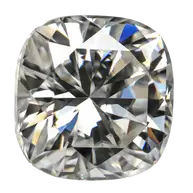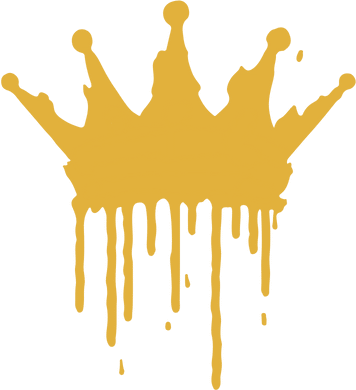
Gabrielle’s Ideals for Square Cushion Diamonds
(Table: 55–62% (57–61%) | Depth: 62–68% (64–66%) | Pavilion Depth: 41–55% (48–54%) | Pavilion Angle: 40–41° (40.2°–41.25°) | Crown Angle: 34–35° (33.7°–35.8°) | Crown Height: 12–15% | Girdle: 2.5–4.5%)
The square cushion cut diamond is a unique blend of brilliant faceting and soft, rounded edges, offering a classic yet modern appeal. Known for its pillowy shape and strong fire, the cushion cut has been a staple in diamond cutting since the 1700s. However, today’s modern cushion cuts have been refined to maximize brilliance while maintaining their distinctive shape.
Unlike other square shapes, the cushion cut is a hybrid of round brilliants and elongated step cuts. Depending on the faceting pattern, it can have either a chunky, defined facet structure or a crushed ice appearance.
1. What Is a Square Cushion Cut Diamond? #
The square cushion cut features a rounded, softened square shape with a brilliant-cut facet structure designed to maximize fire and light dispersion. It differs from other square shapes, like the princess cut, with curved corners and a softer silhouette, making it more durable against chipping.
The length-to-width ratio for a square cushion cut should ideally be 1.00–1.05 to maintain a true square appearance.
Why Choose a Square Cushion Cut Diamond?
-
Timeless & Romantic:
The soft, rounded edges give it a more organic and classic feel than sharp-edged square cuts.
-
Superior Fire (Rainbow Light Dispersion):
Cushion cuts often have strong fire, meaning they display more rainbow flashes than other brilliant cuts.
-
More Durable Than Princess Cuts:
The rounded edges prevent chipping, making cushions more secure for everyday wear.
-
Hides Inclusions Well:
The brilliant-cut facet structure masks inclusions better than step cuts like emerald or Asscher.
-
Softer, More Feminine Aesthetic:
Works beautifully in vintage and modern settings alike.
Potential Downsides of a Square Cushion Cut Diamond
-
Depth Can Make It Face-Up Small:
Cushion cuts tend to have deeper proportions, meaning they can appear smaller than other shapes of the same carat weight.
-
Crushed Ice vs. Chunky Faceting:
Some cushions have a “crushed ice” sparkle, while others feature bigger, well-defined facets—personal preference matters.
-
Can Hold More Color Than Rounds:
Due to its deeper cut, cushion diamonds may show more warmth than round brilliants in the same color grade.
-
Cut Consistency Can Vary:
Because there are different cushion cutting styles, light performance is less standardized than in rounds.
2. The 4Cs for a Square Cushion Cut Diamond #
While the 4Cs—Cut, Color, Clarity, and Carat—are critical for every diamond, the cut is especially vital for square cushions, as it directly governs their light performance.
Cut – The Heart of Square Cushion Brilliance
Getting the cut right means dialing in those key proportions:
-
Table Percentage (IGI’s ideals: 55–62% | Gabrielle’s Ideals: 57-61%):
The table is the largest facet where light enters the diamond. Maintaining this range ensures even light distribution, enhancing both fire and brilliance.
-
Depth Percentage (IGI’s ideals: 62–68% | Gabrielle’s Ideals: 64-66%):
Depth defines the stone’s overall height relative to its width. An optimal depth allows light to bounce effectively within the diamond, preventing it from being lost or trapped.
-
Pavilion Depth (IGI’s ideals: 41–55% | Gabrielle’s Ideals: 48-54%):
The pavilion is where internal reflections occur. Proper pavilion depth directs light back through the crown, maximizing sparkle.
-
Pavilion Angle (IGI’s ideals: 40–41° | Gabrielle’s Ideals: 40.2°–41.25°):
This angle guides the light through the diamond, influencing the interplay of brilliance and scintillation.
-
Crown Angle (IGI’s ideals: 34–35° | Gabrielle’s Ideals: 33.7°–35.8°):
The crown angle is crucial for dispersing light into its colorful spectrum (fire) while ensuring overall brightness.
-
Crown Height (12–15%) & Girdle (2.5–4.5%):
These parameters contribute to the diamond’s durability and visual appeal, ensuring that the stone withstands everyday wear while performing at its best.
Pro Tip: Cushion cuts can vary widely in faceting style—if you prefer a more defined look, opt for a chunky cushion rather than a crushed ice pattern.
Color – Enhancing the Icy Sparkle
Cushion cuts retain color more than rounds, meaning a slightly higher color grade may be preferred.
-
D–F (Colorless): Provides a pristine, icy-white look that maximizes brilliance.
-
G–H (Near Colorless): Offers an excellent balance between value and that sought-after white radiance.
-
I–J: May introduce a subtle warmth—ideal if you plan on setting your diamond in yellow or rose gold, which can complement and balance the tone.
Pro Tip: For settings in yellow or rose gold, an H–J color grade works well, as the metal helps mask any slight warmth.
Clarity – Focus on Structural Integrity
Lab diamonds generally feature fewer inclusions than natural stones. For square cushions, aim for eye-clean clarity to ensure nothing detracts from the stone’s luminous performance:
-
VS1–VS2: The sweet spot—providing excellent clarity and value without visible inclusions.
-
SI1–SI2: Acceptable if inclusions remain invisible to the naked eye.
-
VVS1–VVS2: Nearly flawless, though these stones come at a premium.
-
F–IF: Flawless diamonds exist but are generally unnecessary for most buyers.
Pro Tip: A VVS2 or VS1 is often the perfect clarity choice, ensuring an eye-clean look without overpaying.
Carat – More Size for Your Budget
Square cushion cuts tend to hold more weight in their depth, making them appear slightly smaller per carat than rounds or elongated shapes.
Pro Tip: If maximizing size is a priority, opt for a cushion with a slightly shallower depth within ideal parameters.
3. Additional Considerations #
Symmetry & Polish
-
Symmetry: Excellent symmetry ensures the diamond reflects light evenly for an elegant, well-proportioned appearance.
-
Polish: Excellent or very good polish is the best choice to maximize the crispness and cleanliness of the facets.
Fluorescence
-
None or Faint fluorescence is best—strong fluorescence may create haziness in some stones.
Certification
-
Always buy IGI- or GIA-certified diamonds to ensure accurate grading.
Setting Considerations
-
Metal Choice: White gold or platinum enhances the icy brightness of a square cushion diamond, while yellow or rose gold can add a touch of vintage warmth.
-
Setting Style: Prong settings maximize light exposure, ensuring that every facet contributes to the stone’s stunning sparkle.
Final Thoughts #
A well-cut square cushion diamond is a stunning blend of brilliance, fire, and soft elegance. With rounded corners, strong light dispersion, and a timeless silhouette, the cushion cut is perfect for those who want something unique yet classic.
By following Gabrielle’s Ideals, you can confidently select a cushion cut diamond that is proportionally balanced, high-performing, and undeniably beautiful.
Happy diamond hunting—may your cushion cut diamond glow with warm fire and dazzling brilliance!


